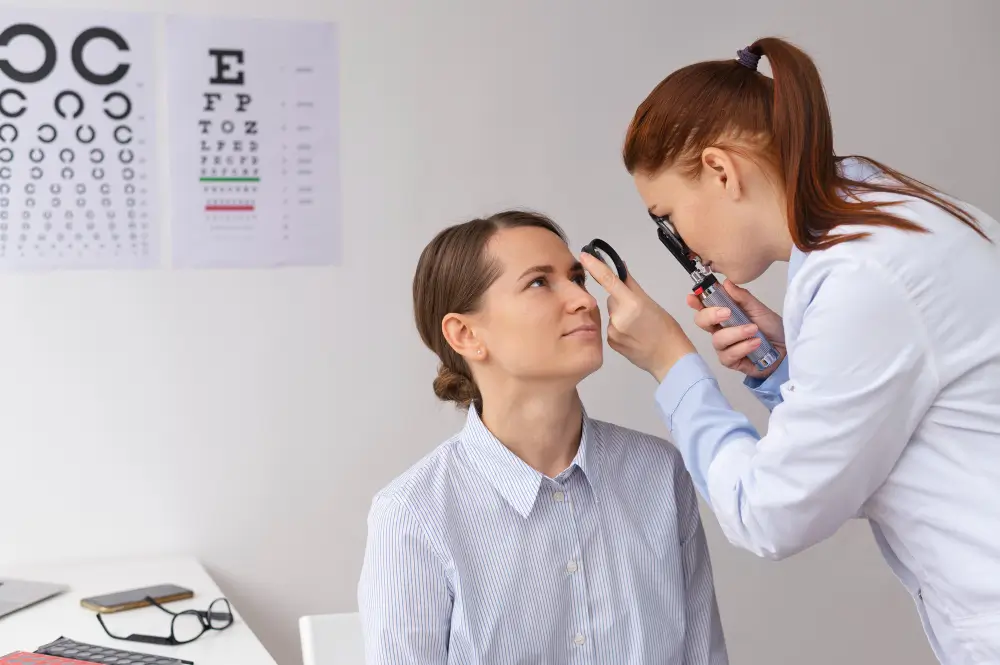Waking up with red, itchy, and watery eyes can be alarming—could it be pink eye? While some cases clear up on their own, others require professional treatment to prevent complications. But what exactly can an optometrist do to help? From identifying the cause to prescribing the right treatment, their role might surprise you. Before you try home remedies, here’s what you need to know.
Contact optometrists in Bronx for pink eye treatment options.

When Should You See an Optometrist for Pink Eye?
Pink eye, or conjunctivitis, is a common condition that can cause redness, itching, and discomfort. While many cases are mild and resolve on their own, some situations require medical attention. An optometrist can help determine the cause—whether viral, bacterial, allergic, or environmental—and recommend the appropriate treatment.
You should see an optometrist if you experience severe pain, vision changes, intense redness, or sensitivity to light, as these could indicate a more serious infection or underlying condition. Additionally, if symptoms worsen or persist beyond a few days, or if there is thick discharge, swelling, or difficulty opening the eye, professional care is recommended.
People with weakened immune systems, pre existing eye conditions, or recent eye surgeries should seek prompt medical evaluation to avoid complications. Early diagnosis and proper treatment can help relieve discomfort, prevent spreading, and protect long-term eye health.
1. Persistent redness in one or both eyes
Redness is a common pink eye symptom, but if it persists or worsens, it may indicate a more serious issue. While viral or allergic conjunctivitis often clears up on its own, prolonged redness could signal bacterial conjunctivitis, keratitis, or an autoimmune condition.
If redness is accompanied by pain, light sensitivity, vision changes, or discharge, an optometrist can determine if prescription treatment is needed. Seeking timely care helps prevent complications and protects eye health.
2. Discharge or crusting around the eyes, especially upon waking up
Mild pink eye may cause a watery discharge, but if you notice thick yellow, green, or white discharge that makes your eyelids stick together in the morning, it could be a sign of bacterial conjunctivitis. This type of infection may require antibiotic eye drops or ointments to clear the bacteria and prevent complications.
If symptoms persist or worsen after 24 hours of starting antibiotics, a follow-up visit is necessary to ensure proper treatment. Seeking timely care can help speed recovery and prevent the infection from spreading.
3. Itchy, watery, or gritty feeling in the eyes
A gritty sensation, excessive tearing, and itchiness are common signs of allergic conjunctivitis. While mild cases may improve with simple remedies, persistent discomfort could indicate an underlying issue. Consider the following factors when managing these symptoms:
- Allergic Conjunctivitis – Often triggered by allergens like pollen or pet dander, it can be relieved with over-the-counter antihistamine eye drops.
- Persistent Symptoms – If irritation continues despite avoiding allergens, stronger prescription medication may be needed.
- Other Possible Conditions – If symptoms do not improve, an eye doctor can assess for dry eye syndrome or blepharitis, which may require specialized treatment.
4. Sensitivity to light
While a pink eye may cause slight discomfort in bright light, significant light sensitivity can be a sign of a more serious eye condition. If you experience pain, excessive squinting, or difficulty tolerating bright environments, it’s important to seek medical attention.
- Potential Causes – Severe light sensitivity could indicate conditions such as a corneal ulcer, uveitis, or a herpes simplex eye infection, which require prompt treatment.
- When to See a Doctor – If sensitivity is accompanied by pain, vision changes, or redness that worsens, an eye exam is necessary to rule out vision-threatening issues.
5. Blurry vision or pain in the eyes
Blurry vision can occur due to watery eyes or discharge from pink eye, it should clear up once the eyes are cleaned. If vision remains blurry, it may indicate corneal involvement or a deeper infection that requires medical attention.
- Blurry Vision – If vision does not improve after wiping away discharge, it could signal a more serious eye condition affecting the cornea.
- Eye Pain – Mild conjunctivitis usually does not cause significant pain. Persistent discomfort may indicate an ulcer, glaucoma, or another urgent issue.
- When to Seek Care – If you experience ongoing blurry vision or pain, schedule an optometrist appointment as soon as possible to prevent complications.
Tips for Preventing Pink Eye and Promoting Healing
Taking preventive measures and practicing good hygiene can help reduce the risk of pink eye and promote faster recovery. Follow these essential tips:
- Practice Good Hygiene – Wash hands frequently, avoid touching your eyes, and use clean towels to prevent infection from spreading.
- Disinfect Contact Lenses and Cases – Poor lens hygiene can lead to bacterial pink eye, so always clean and replace lenses as directed.
- Avoid Allergens and Irritants – Minimize exposure to triggers like pollen, pet dander, or smoke, and use artificial tears to flush out irritants.
- Don’t Share Personal Items – Avoid sharing towels, eye makeup, or contact lenses to reduce the risk of transmission.
- Seek Timely Medical Care – If symptoms worsen or persist, an eye doctor can provide proper treatment to prevent complications.
The Importance of Early Diagnosis and Treatment
While pink eye is often mild, bacterial and viral conjunctivitis can spread rapidly. Seeking medical care for severe or prolonged symptoms helps ensure proper treatment and prevents complications like corneal scarring or secondary infections. If the cause is unclear, an optometrist can perform an exam, take samples, and recommend the best course of action. Early diagnosis is pivotal to effective management and faster recovery.
Sources.
Iqbal, T., & Altaf, S. (2024). Overview of pink eye infection (Conjunctivitis). Biological Times, 2(12), 70-71.
Kneen, L. (2022). Red Eye/Pinkeye. Point-of-Care Quick Reference.
